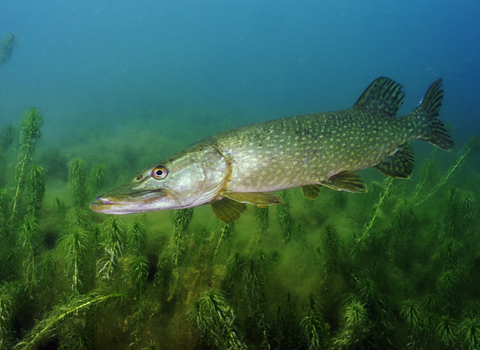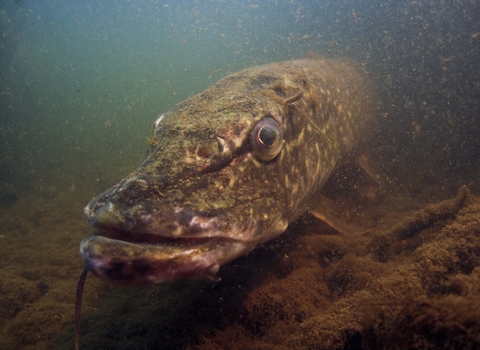
Pike ©Linda Pitkin/2020VISION

Pike ©Bertie Gregory/2020VISION
Pike
Famously predatory, the long, slender pike will lurk among the vegetation of a river or lake, bursting out with ferocious speed to catch its prey. Look out for it across the UK.
Scientific name
Esox luciusWhen to see
January to DecemberSpecies information
Category
Statistics
Length: 0.6-1.5mWeight: up to 35kg
Average Lifespan: 10-25 years
Common.
Habitats
About
The pike is a large fish that can grow over a metre in length. It is found in lakes and slow-flowing rivers and canals that have a lot of vegetation. It uses these plants as hiding places when hunting, bursting out with remarkable speed to catch fish, frogs, small mammals or ducklings. Young pike are called 'jack' and will eat small fish and invertebrates. Pike spawn between March and May, returning to the same place every year. A large female can produce up to 500,000 eggs.How to identify
The pike is a long, slender fish with a narrow, tapered head, large eyes, a flattened snout and a large mouth full of sharp teeth. It is olive green in colour, with creamy blotches.Distribution
Widespread.Did you know?
A pike can eat a prey item up to half its own body weight, even taking moorhens or young ducks. Because of its size and predatory nature there are many stories about very large pike. The largest specimen caught in the UK so far was found in 1992 in a lake in Wales: it weighed in at just over 21kg - over a third of the weight of an average British woman. Larger fish have been caught abroad and there are stories of huge pike possibly weighing up to 42kg.Watch
Pike (https://vimeo.com/647242963)
Jack Perks
